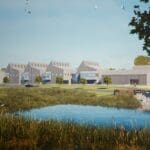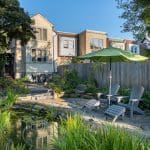
Adding urban green spaces to cities can greatly improve their sustainability and boost the quality of life for residents. As cities continue to grow, green spaces can shrink but it’s critical to fight for these areas and increase their presence in urban areas.
Why Urban Green Spaces Matter
Urban green spaces have been dubbed the green lungs of the city as they help improve the air quality of the area and aid with carbon sequestration.
For every urban tree strategically planted to provide shade, reduced demand for air conditioning could directly reduce carbon emissions from power plants by approximately 10 kg, according to the National Library of Medicine.
Green spaces can also mitigate heat island effects and improve stormwater management.
Socially, these locations can also improve enhanced mental health and well-being for nearby residents. Being in contact with the natural environment can alleviate stress and anxiety, boosting individuals’ moods. They also provide free and accessible opportunities for physical activity. Urban green spaces also serve as a space for social interaction and fosters a greater sense of community.
It has also been found that urban green spaces can increase property values and boost local businesses and tourism.
Overcoming the Battle for Space
One of the major challenges to increasing urban green spaces is the lack of available land. However, you can still implement green spaces even if you don’t have the sweeping acreage like Central Park. Stress to your clients that every little bit helps.
Creating innovative designs that maximize the green space in an urban environment is key. The High Line in New York City is a good example of reusing an underutilized space for green purposes. This elevated train track was originally slated for demolition and now it is a 1.45-mile greenway featuring 500+ species of plants and trees.
Pocket parks are other small green spaces you can add to dense urban areas. If your client has unused or an irregularly shaped section of their property that serves no purpose, suggest transforming this into a green space. Paley Park is an example of this as in 1967, William Paley dedicated the 4,200 square foot space to his father.
“As a New Yorker, I have long been convinced that, in the midst of all this building, we ought to set aside occasional spots of open space where our residents and visitors can sit and enjoy themselves as they pause in their day’s activities,” Paley said after the park’s opening. “When I was casting about for an appropriate way to create a memorial to my father, it occurred to me that to provide one such area in the very center of our greatest city would be the kind of memorial that would have pleased him most.”
Another way to take advantage of the existing space is to add green walls or rooftop gardens. The California Academy of Sciences takes this idea to the next level and has rolling hills and fields covering 87% of their 2.5-acre rootftop. An estimated 1.7 million plants fill biodegradable vegetation trays, creating an oasis for birds, insects, people, and other creatures.
In Chicago, they have the Green Alley program, which started in 2001, and now has more than 300 green alleys across the city featuring permeable pavement, bioswales and rain gardens.
Mini forests, community gardens and parklets are all other green space options you can explore if you are limited by the scope of the land available.
Minimizing Maintenance
Clients can also be reluctant to invest in urban green spaces because they perceive them as expensive and doomed to fail. Educate your customers on the many benefits urban green spaces can provide. You can also remind them of the long-term value the spaces create for the community as a whole.
While urban green spaces do face additional stressors like soil compaction and contamination, opting to install urban green spaces with sustainable landscaping practices can help set them up for success.
No green space will ever be no maintenance, but selecting native plants and those with low water needs can keep the space low maintenance. Utilizing drip irrigation can minimize water waste and integrated pest management practices can help reduce the need for inputs.
Regularly monitoring the green space for issues and addressing them early on can also reduce time and resources required to resolve the problem.
You can also suggest your client use the space as a volunteer opportunity for the local community to get involved in caring for the space. Shared responsibility fosters a sense of ownership and pride in the green space, leading to better upkeep.




